Chapter 7
Creating Your Twittertorial Calendar
“Look in the Calendar and bring me word.”
Julius Caesar
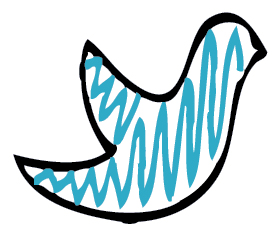
One of the main gripes voiced about shifting to a social-media-centric way of promotion is the amount of hours we see each of the various platforms eating into our precious time. That’s why flexible scheduling is so important. I say “flexible” because there’s only so much content, or foundation tweets as I call them, that you can use at a later date without things changing and removing its value.
Creating content that is particularly relevant to your followers at that very moment has disproportionately high benefits. Being on-trend not only gives you structure (relieving you from the “what should I write about next?” dilemma) but also increases the likelihood that people will interact with your content, that it will be retweeted, and that it will warrant an eventual call to action in terms of revenue possibilities.
It’s All in the Planning
When I first started building my personal brand on Twitter, I did so in a “fly by the seat of my pants,” ad-hoc fashion. As my following started to substantially grow, however, it became more and more difficult to manage the time and flow of my content. I realized there had to be a more efficient way of managing my content stream, so I looked to traditional methods of planning to build my formula on.
My mind wandered back to my days at News International in England, where our editorial calendars were our bibles, and a “Eureka!” moment occurred. Surely I could adopt the same principles of content management and transfer them to my social media platforms to bring much needed structure to my content stream.
I realized that the goal of reflecting what is current and relevant to my audience was something of an art form, but by linking to trusted curation sources (which I explain later in this chapter), you can master the art of great Twitter content and set it down in calendar form.
This realization came to me prior to defining the four types of tweets, which I introduced in Chapter 5. In fact, putting together my Twitter-centered editorial calendar — or my Twittertorial calendar as I now like to call it — helped me realize how different types of tweets could work in synergy to effectively promote a brand message.
Planning your Twittertorial calendar in advance takes courage. To begin with, it can feel a little like stumbling around in the dark. You’re not entirely sure what you can reach out and grab onto for support along the way, and the ground below can seem unsteady. Again, this is where the power of your personal brand statement will play a huge part in helping you plot your course.
Mastering the Art of Clever Curation
Make no mistake, clever curation is indeed an art form that starts with a clear understanding of your personal brand statement, which I introduced in Chapter 3. You need to fully comprehend all it stands for and all that you, as a personal brand, want to achieve from its message. It’s a case of mentally dissecting your brand into clearly definable and highly searchable keywords and phrases that will lay the foundation for your curation framework.
Using my @grattongirl brand as an example, my personal brand statement reads, “I delight in helping others create and unleash their personal brand on Twitter.”
I can break the keywords down to “help,” “create,” and “branding” and then build on these words to find searchable keyword alternatives such as:
- Help = assist, support, guide, teach, show, explain
- Create = build, produce, craft, make
- Branding = Imprinting, stamping, marking
I can then break my statement down into searchable phrases such as “I delight in helping others create and unleash their personal brand on Twitter”:
- Creating a personal brand
- Building a personal brand
- Unleashing your personal brand
Or “I delight in helping others create and unleash their personal brand on Twitter”:
- The joy in helping others
- The joy of giving
- Motivational support
Or “I delight in helping others create and unleash their personal brand on Twitter”:
- Twitter help
- Using Twitter creatively
- Creating your brand on Twitter
And there are dozens more combinations I can draw on to find the most brand-relevant content for my followers.
Next, I use my keywords and phrases to find fresh and relevant content on my search engine sites and other great curation resources such as StumbleUpon (see Figure 7-1). This content will make up my Inform tweets, which I introduced in Chapter 5.
Figure 7-1
StumbleUpon is a great curation tool for locating new content based on your keywords.
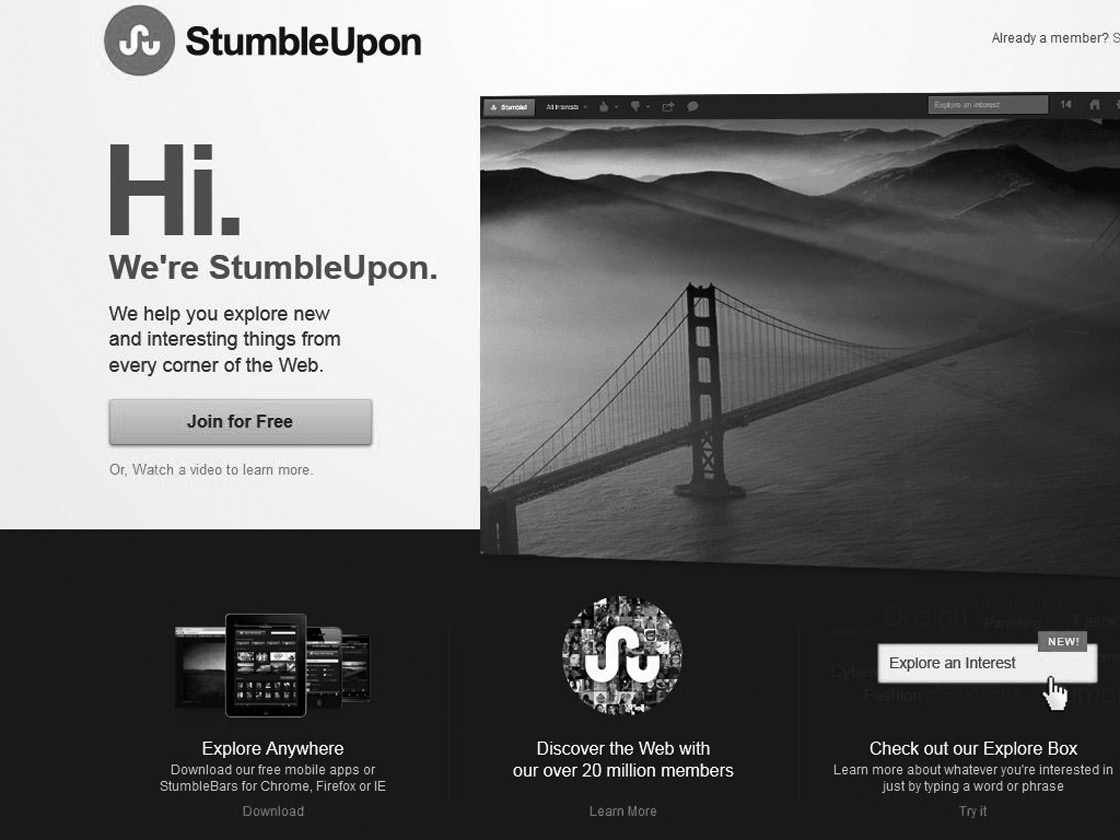
Be sure to check the dates of any sites you search for on Google using its Search Tools option in the bottom left of the Google website to make sure they contain current information (see Figure 7-2). Be sure to also check the dates of any content found on StumbleUpon to keep your links as up to date as possible.
Figure 7-2
Google’s Search Tools feature makes it easy to customize your search and locate the latest content to keep your tweets fresh and relevant.
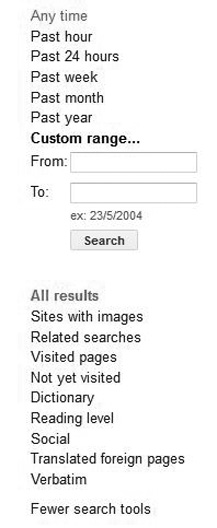
Once you’ve curated a great range of content that fits well with your personal brand, save a brief summary of each proposed tweet with a link to the URL where the content can be found. I place mine in a separate folder on my computer so I know where to easily find them. My folder is labeled Curation and is broken into subfolders determined by my keywords to make my curated content easier to locate when I put together my calendar (see Figure 7-3).
Figure 7-3
Organize your curation in a main folder containing sub-folders based on your personal brand keyword findings.
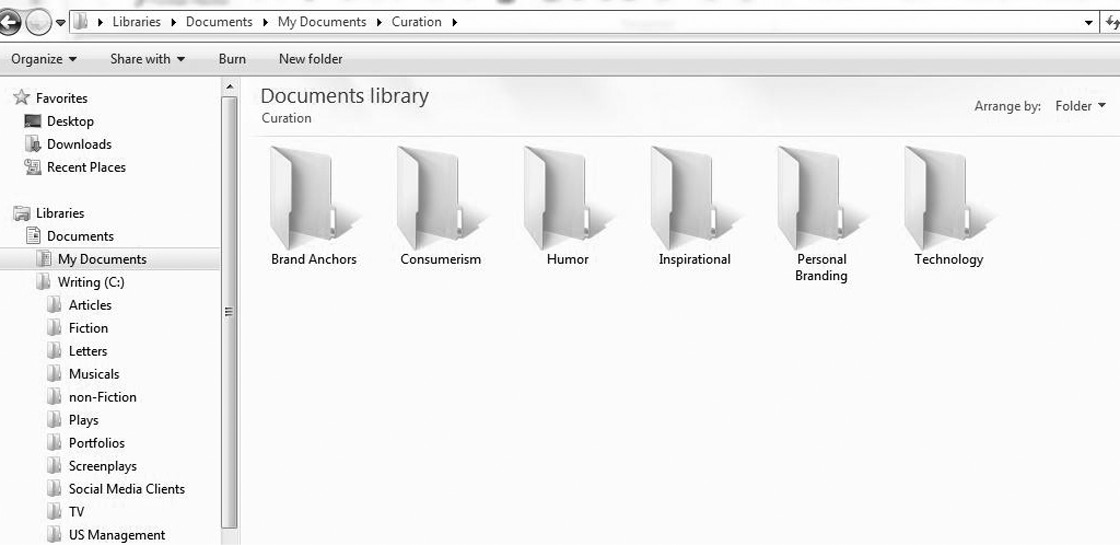
Creating Your Brand Anchors
Having curated a great range of content for your brand from other sources on the web, the next step is to compile links to every article, post, infographic, quote, and other related item that is either written by or attributed directly to you. I call these your brand anchors, as they are fundamentally routed in brand “you.”
Once you’ve put together your brand anchors, it’s time to get creative with your proposed tweets to draw your audience to them. For example, the links to my books are great brand anchors and I have found a variety of ways to direct my followers to their online order pages using creative tweeting, as shown below in Figures 7-4.
Figure 7-4
Some example brand anchor tweets, enticing followers to check out (and with any luck purchase) this book.
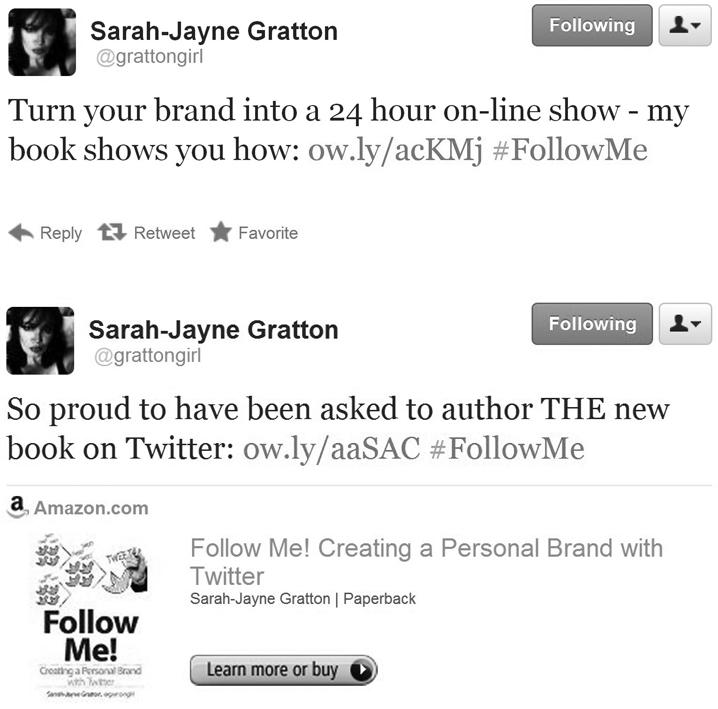
Using Key Events
All good curators draw on key events throughout the year to source new content that best showcases their brand message. Start by looking at future events that have a personal connection to brand “you.” A florist, for example, would pay particular attention to Mother’s Day and Valentine’s Day and mark them as key occasions in his or her Twittertorial calendar. A technology consultant would probably include SXSW and CeBIT in his or her lists. As you create your list, make sure that every event has a date associated with it for your calendar.
Order the list by date, and begin by focusing on the events occurring in the next three months. Also pay particular attention to the biggest events in your year ahead and those where you are speaking or contributing in some way. In fact, try to find as many ways of associating your brand with these events to turn them from curated links to brand anchors that showcase brand “you”!
A Little More Courage
Don’t be afraid to let your imagination run away in this process. Think of different takes on how you present your content. For example, if you’re planning to cover a local industry event, why not start a tweetup among the attendees, with a specific hashtag (I explain more about this in Chapter 10) to bring a sense of community to both the event and to your followers, who can then also participate via your united tweets. A tweetup, as I introduced in Chapter 6, is basically a means of forming a Twitter group at a get-together, which is then tweeted out to each of the attendee’s followers. It’s a great way of bringing like-minded tweeters together and building on your following at the same time. You can use your Twittertorial calendar to both initiate and promote the tweetup and, of course, to follow up on it after the event.
If you’re aware that relevant industry data is going to be published, plan ahead and have a template ready to create a unique infographic of it, which you can tweet to your followers.
If you’re aware that a competitor is about to announce a new product or service, don’t be afraid to steal its limelight by tweeting something to distract attention from it, whether it be a new report that leads opinion in a different direction or news of something equally big from your side of the trenches. For example, I don’t think it’s a coincidence that Microsoft allegedly tried to generate buzz by revealing the new Windows 8 logo on the same day that Apple’s OS X Mountain Lion was announced.
Your Content List
The following is an exaggerated example list of what you might now have to work with based on a huge amount of personal interests. Not everyone will have a range as wide as this and, as previously mentioned, it’s good to hone your list into a personal, brand-specific niche. But I hope it will give you an idea of how your list could look at this stage:
- Your brand anchors, including blog post links, other article links, your product or service links, other links relating to you (press releases, citations, and mentions), and personal insight links (photos, quotes, and memories that have emotional value).
- Your industry's/niche’s Inform tweets, including industry news and events, local events and tweetups, annual reports and research reports, industry awards, industry conferences (especially those you will attend or at which you are speaking), industry exhibitions (especially those you will attend or at which you exhibit), partner events, new product/service/industry launches in your arena, product/service upgrades and relaunches, announcements about big new clients, and competitors
- Occasions, including niche events and celebrations (for example, Crufts for dog lovers and planting season for gardeners), widely recognized events (for example, National Book Month), and events just made up for PR (for example, National Taco Week)
- Politics and community topics, including local/regional/national election cycles, new laws and bills, openings and closing of political seasons, and annual budget announcement
- Holidays and celebrations, including public holidays, bank and federal holidays, other national holidays, things that everyone celebrates (such as major sports championships or end of the school year), unofficial holidays (such as Valentine’s Day, Halloween, Mother’s Day, Father’s Day, April Fool’s Day, Friday the 13th, February 29th, and Pi Day), holidays from other cultures, the first day of spring/summer/fall/winter, the equinoxes and solstices, the start and end of daylight savings time, and the tax season
- Humorous quotes relating to your interests
- Photography that tells a story relating to brand “you.”
- Events, such as historical events (such as the Battle of Hastings, 9/11, Bloody Sunday, D-Day, Columbus’s landing in the Americas, the fall of the Berlin Wall, and the Ides of March), celebrity birthdays/marriages/deaths, science/technology events (for example, the first moon landing and the first World’s Fair), tragic events (such as natural disasters and plane crashes), once-in-a-lifetime events (such as Halley’s Comet, the last NASA space shuttle launch, the royal wedding/coronation, a solar eclipse, the turn of a century), and independence days
- Sporting events, including annual sports events (such as the Super Bowl, FA Cup Final, varsity rugby, and local boat race), annual sporting seasons (such as the NFL playoffs, the Six Nations, and March Madness), periodic sporting events (such as the Ryder Cup, Olympics, Commonwealth Games, Ashes, UEFA Championship, and Cricket World Cup)
- TV, film, and stage, including the first episode and final episode or new season of popular TV shows, TV scheduling seasons (for example, the fall TV schedule), big movie releases, new stage shows (such as theatrical plays, musicals, ballet, and opera), and awards shows (such as the Oscars, BAFTAs, Emmys, and Tonys)
- Music, including big album/single releases, chart announcements (for example, Christmas Number 1 and Festive Fifty), artists on tour, festivals (such as Coachella, Glastonbury, Burning Man, and Latitude), and awards shows (such as the Grammys, Country Music Awards, and British idol)
- Shopping and products, including anticipated new product releases (such as new tablets and the latest model cars), video game releases, limited-availability products (such as Girl Scout Cookies and Cadbury’s Creme Eggs), new store openings, and shopping events (such as the spring sale season, Black Friday, and Back to School)
- Publishing, including book series installments (such as the latest Twilight novel), big magazine events (such as the Economist’s The World in 2012 and Sports Illustrated’s swimsuit edition)
Putting It All Together
So now you have all the pieces to your puzzle. But bear in mind that the list itself is far from definitive. The key now is to put its items together in a way that paints a clear picture of your brand.
You can use your list of curated content to create your foundation tweets. These are the tweets that stay in your calendar and can be planned and positioned well in advance.
You can also use your keywords and phrases to add suggestion tweets to the calendar. These are tweets that need to contain freshly curated content to keep them current.
Whatever month you choose as the first month to start tweeting from your Twittertorial calendar is Month 1. Let’s say you’re starting to plan your Twittertorial calendar in September to begin using in October. In this case, October is Month 1, November is Month 2 and so on. You’ll need to incorporate your four types of tweets in your calendar’s construction, so the first day of Month 1 might look like the one in Figure 7-5.
Figure 7-5
An example of how the foundation tweets in a Twittertorial calendar might look.

Day 1 shows my brand anchor tweets for the day in blue. These are also foundation tweets, accessible from my folders and personal links and are unlikely to need amending. The other tweets are suggestion tweets that point the way for me to curate great content for the day.
Notice that I don’t include any Thank or Engage tweet notifications. These are necessary but reactionary tweets that can occur at different times each day and are wholly dependent on follower behavior and content, making calendar placement impossible.
Also notice that, at this stage, I haven’t allocated specific times for the tweets to go out but have merely planned the content I want to provide for my followers. I explain more about why this is the case in the next two chapters.
What you need to do now is to turn your Twittertorial calendar into your own unique brand show. So, what are you waiting for?

